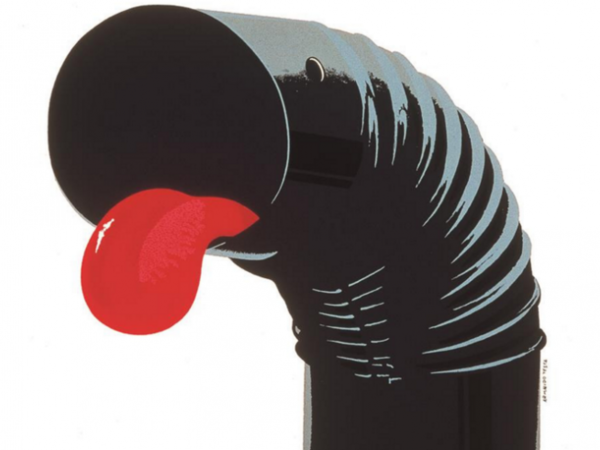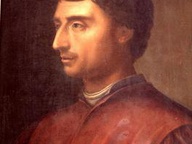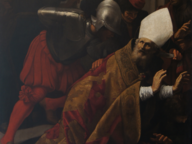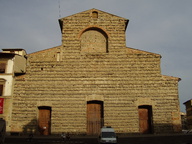Armando Testa. Punto e Basta

Opera di Armando Testa
From 18 Aprile 2018 to 01 Giugno 2018
Milan
Place: Galleria Lia Rumma
Address: via Stilicone 19
Times: Tuesday – Saturday 11am – 1.30pm / 2.30pm – 7pm
Telefono per informazioni: +39.02.29000101
E-Mail info: info@liarumma.it
Official site: http://www.liarumma.it
Galleria Lia Rumma is pleased to present a solo exhibition of works by Armando Testa, under the title “punto e basta”.
Armando Testa was one of Italy’s greatest creative minds, a protagonist of contemporary visual culture, and the creator of symbols that have entered the collective imagination. He explored countless visual forms and created timeless masterpieces, the modernity of which is now a source of inspiration for contemporary artists. His works reveal a great understanding of the semiotic and visual processes that are at the heart of our system of communication, using his images to create double entendres and new meanings. The outcome of extensive archive research, the exhibition includes drawings, screen prints and photographs, but also paintings, sculptures, and design objects, with the aim of exploring the conceptual aspects of Testa’s work. It shows how his intuitive understanding of communication was the result of a creative process that originated in art. This was then transformed to create images that reflected the changes that were under way and a future that was not yet visible to all. A perfect example of this process is his Uno e mezzosculpture (1960), on display in the first room: it is what we all know as Punt e Mes – an image linked to the logo of the famous Carpano vermouth. It actually came from a minimalist sculpture of the mid-1950s, which consisted of a sphere reduced by half in starkest simplicity. Accompanying it, in the first room, there is also a series of works that combine Armando Testa’s interest in art with his interest in design. On one wall we find a series of works made of laminate, with elaborate period frames place around them to highlight the pictorial value of the works themselves, in an explicit tribute to the great Piet Mondrian. They recall the frames used to mount antique mirrors, which have been replaced by paintings made of perpendicular lines and geometrical blocks of primary colours, coupled with black and white. It is as though Testa were telling us that, rather than reflecting our own images, we should aspire to a constant search for the harmony and formal perfection that Mondrian achieved in his art. In front of each of these paintings is the universally renowned Sedia AT(1990), the chair made using the shape of his initials in their most elementary form, with the seat in the shape of an A and the back in that of a T. These chairs have performative overtones, for Testa drew inspiration for them from a real situation, probably one of the countless conferences he attended, in which the speaker turned out to be intensely boring. This gave him the idea of a roomful of these units and the public, himself included, would turn round and sit astride the chair, with their arms and heads on the T. During the most critical moments of the conference, they would start snoring loudly. Following his own instructions, these chairs are shown in the exhibition as though they were kneelers in a church, expressing even more forcefully the idea of mirroring and, at the same time, contemplating the geometrical shapes of the works inspired by Mondrian. The room also has another three works. A chair-pencil in which one of the legs is in the form of a pencil that pierces the seat, creating a precarious equilibrium. The object symbolises the love-hate relationship he had with his profession: martyred in his body when forced to sit for hours on end, but at the same time with joy in his mind during the act of creation. Next to this is his Armadio Y cupboard (1971), which represents one of the identifying features of a person in our imagination, and in its use. Testa decides to decorate it with a large letter of the alphabet in relief: the juxtaposition of different letters is well-suited to the creation of personal messages. The works are accompanied by his anthropomorphic chair, or Sedia Antropomorfa, of 1976, which suggests the idea of both an object and a person. The dominant theme on the first floor is that of hands and, in particular, of fingers. Testa had a real obsession with fingers, which he often used as images in his works, as we see in the composite series of drawings, watercolours and small paintings shown on one of the walls of the room, which he made from the 1960s. We also see this in the series of photos on display on the wall opposite. The intention behind the display is to show how the image of hands and fingers conceptually embraces the other works on show here. This is clear to see in the Mani series of ceramic hands, made between 1969 and 1987 and, in a subtler way, in the mechanical eagle, Aquila meccanica (1977), the realism of which is upset by the insertion of a mechanical eye and the disorienting colour of the industrial paint that covers the feathers of the royal bird. Once again highlighting the importance of the role and iconography of hands, they represent the artist’s fingerprints. The exhibition ends on the second floor with some of Testa’s most famous and best-known creations, which he made from the end of the 1950s in the form of fantastical characters and animals. These often came from visual games played between the Pop language of the subjects and the surrealism of the materials. Sculptures devoted to the subject of food, designed from the 1960s, are shown alongside these works. The following works are on show: Michetta energetica[Energy Roll](1968), Tavolo riservato con scarpine [Reserved Table with Slippers](1980), Stallone Sylvestre(1986), Spadaccini infiammati [Flame Fencers] (1987) and Nocero Umbro(1991). In the same room there is also Omaggio a Armando Testa(1995), a tribute to Armando Testa by Haim Steinbach, which shows some icons of Armando’s advertising work next to an everyday object. Papalla,Caballero and Carmencitaall represent a narrative world that is well known to the general public, coupled with a more personal, intimate sphere symbolised by the frog character. The exhibition ends with Lampadina limone [Lemon Lightbulb], a brilliant invention of 1968, and an emblem and symbol of Armando Testa’s creative spirit coupled with his subtle sense of humour.
Armando Testa was one of Italy’s greatest creative minds, a protagonist of contemporary visual culture, and the creator of symbols that have entered the collective imagination. He explored countless visual forms and created timeless masterpieces, the modernity of which is now a source of inspiration for contemporary artists. His works reveal a great understanding of the semiotic and visual processes that are at the heart of our system of communication, using his images to create double entendres and new meanings. The outcome of extensive archive research, the exhibition includes drawings, screen prints and photographs, but also paintings, sculptures, and design objects, with the aim of exploring the conceptual aspects of Testa’s work. It shows how his intuitive understanding of communication was the result of a creative process that originated in art. This was then transformed to create images that reflected the changes that were under way and a future that was not yet visible to all. A perfect example of this process is his Uno e mezzosculpture (1960), on display in the first room: it is what we all know as Punt e Mes – an image linked to the logo of the famous Carpano vermouth. It actually came from a minimalist sculpture of the mid-1950s, which consisted of a sphere reduced by half in starkest simplicity. Accompanying it, in the first room, there is also a series of works that combine Armando Testa’s interest in art with his interest in design. On one wall we find a series of works made of laminate, with elaborate period frames place around them to highlight the pictorial value of the works themselves, in an explicit tribute to the great Piet Mondrian. They recall the frames used to mount antique mirrors, which have been replaced by paintings made of perpendicular lines and geometrical blocks of primary colours, coupled with black and white. It is as though Testa were telling us that, rather than reflecting our own images, we should aspire to a constant search for the harmony and formal perfection that Mondrian achieved in his art. In front of each of these paintings is the universally renowned Sedia AT(1990), the chair made using the shape of his initials in their most elementary form, with the seat in the shape of an A and the back in that of a T. These chairs have performative overtones, for Testa drew inspiration for them from a real situation, probably one of the countless conferences he attended, in which the speaker turned out to be intensely boring. This gave him the idea of a roomful of these units and the public, himself included, would turn round and sit astride the chair, with their arms and heads on the T. During the most critical moments of the conference, they would start snoring loudly. Following his own instructions, these chairs are shown in the exhibition as though they were kneelers in a church, expressing even more forcefully the idea of mirroring and, at the same time, contemplating the geometrical shapes of the works inspired by Mondrian. The room also has another three works. A chair-pencil in which one of the legs is in the form of a pencil that pierces the seat, creating a precarious equilibrium. The object symbolises the love-hate relationship he had with his profession: martyred in his body when forced to sit for hours on end, but at the same time with joy in his mind during the act of creation. Next to this is his Armadio Y cupboard (1971), which represents one of the identifying features of a person in our imagination, and in its use. Testa decides to decorate it with a large letter of the alphabet in relief: the juxtaposition of different letters is well-suited to the creation of personal messages. The works are accompanied by his anthropomorphic chair, or Sedia Antropomorfa, of 1976, which suggests the idea of both an object and a person. The dominant theme on the first floor is that of hands and, in particular, of fingers. Testa had a real obsession with fingers, which he often used as images in his works, as we see in the composite series of drawings, watercolours and small paintings shown on one of the walls of the room, which he made from the 1960s. We also see this in the series of photos on display on the wall opposite. The intention behind the display is to show how the image of hands and fingers conceptually embraces the other works on show here. This is clear to see in the Mani series of ceramic hands, made between 1969 and 1987 and, in a subtler way, in the mechanical eagle, Aquila meccanica (1977), the realism of which is upset by the insertion of a mechanical eye and the disorienting colour of the industrial paint that covers the feathers of the royal bird. Once again highlighting the importance of the role and iconography of hands, they represent the artist’s fingerprints. The exhibition ends on the second floor with some of Testa’s most famous and best-known creations, which he made from the end of the 1950s in the form of fantastical characters and animals. These often came from visual games played between the Pop language of the subjects and the surrealism of the materials. Sculptures devoted to the subject of food, designed from the 1960s, are shown alongside these works. The following works are on show: Michetta energetica[Energy Roll](1968), Tavolo riservato con scarpine [Reserved Table with Slippers](1980), Stallone Sylvestre(1986), Spadaccini infiammati [Flame Fencers] (1987) and Nocero Umbro(1991). In the same room there is also Omaggio a Armando Testa(1995), a tribute to Armando Testa by Haim Steinbach, which shows some icons of Armando’s advertising work next to an everyday object. Papalla,Caballero and Carmencitaall represent a narrative world that is well known to the general public, coupled with a more personal, intimate sphere symbolised by the frog character. The exhibition ends with Lampadina limone [Lemon Lightbulb], a brilliant invention of 1968, and an emblem and symbol of Armando Testa’s creative spirit coupled with his subtle sense of humour.
SCARICA IL COMUNICATO IN PDF
COMMENTI

-
 Dal 31 gennaio 2024 al 04 maggio 2025
Fermo | Palazzo dei Priori
Dal 31 gennaio 2024 al 04 maggio 2025
Fermo | Palazzo dei Priori
-
 Dal 20 dicembre 2024 al 04 maggio 2025
Fermo | Palazzo dei Priori
Dal 20 dicembre 2024 al 04 maggio 2025
Fermo | Palazzo dei Priori
-
 Dal 20 dicembre 2024 al 04 maggio 2024
Gorizia | Palazzo Attems Petzenstein
Dal 20 dicembre 2024 al 04 maggio 2024
Gorizia | Palazzo Attems Petzenstein
-
 Dal 18 dicembre 2024 al 18 dicembre 2024
Venezia | Museo Correr
Dal 18 dicembre 2024 al 18 dicembre 2024
Venezia | Museo Correr
-
 Dal 14 dicembre 2024 al 02 marzo 2025
Palermo | Palazzo Abatellis
Dal 14 dicembre 2024 al 02 marzo 2025
Palermo | Palazzo Abatellis
-
 Dal 12 dicembre 2024 al 23 febbraio 2025
Roma | Palazzo Altemps
Dal 12 dicembre 2024 al 23 febbraio 2025
Roma | Palazzo Altemps


